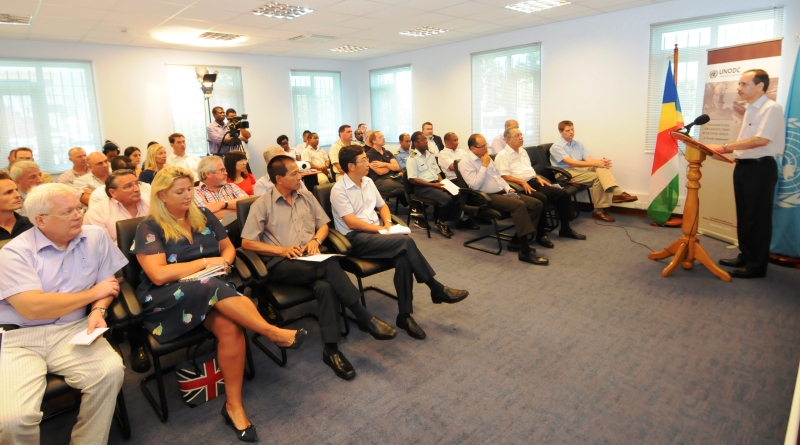UN Report on Transnational Organised Crime Released in Seychelles
Source: Seychelles Nation
THE latest report by the United Nation’s Office on Drugs and Crime, UNODC was officially launched in Seychelles yesterday, 23 Sep, and a copy was presented to Minister Joel Morgan by the UN body’s regional programme coordinator Alan Cole.

The Minister for Home Affairs and Transport received the document entitled ‘Transnational Organised Crime Threat Assessment for East Africa 2013’ during a short ceremony at the Regional Anti-Piracy Prosecutions Intelligence Co-ordination Centre (Rappicc) situated at the ex-guard base on Bois de Rose Avenue.
This was in the presence of the principal secretary for Foreign Affairs Maurice Loustau-Lalanne members of the diplomatic corps, various UNODC regional representatives and other guests.
The report which the UNODC released earlier this month is considered important for Seychelles as it highlights the most pressing transnational organised crime threats facing the region. These are migrant smuggling from Ethiopia and Somalia to Yemen and Saudi Arabia, heroin trafficking from South-West Asia to Eastern Africa, ivory trafficking through Eastern Africa to Asia, and Somali maritime piracy.
Accepting the document Minister Morgan noted that criminal gangs operate and flourish in areas of weakness.
“Pirate gangs thrived in Somalia and now we know that as a result of concerted effort between Seychelles and its regional and international partners this activity is diminishing but we also know that the criminals will stop at nothing to obtain wealth by desperate means and measures,” noted Minister Morgan.
He added that Seychelles welcomes the report as it confirms why the government recently took the decision for Seychelles to establish a Transnational Crime and Maritime Security Centre in Victoria.
Minister Morgan went on to explain that the regional impact of this will be to create a multidisciplinary, multinational centre to support transnational law enforcement cooperation and to better integrate a number of regionally based initiatives aimed at regional capacity building.
“The only way to combat piracy in the region and transnational criminal gangs who exploit the weak and build their empires on the backs of their victims is through a concerted vision and approach,” added the minister.
He said the report will be well analysed and supported as Seychelles through its own transnational crime centre is doing its part with the help of its partners to bring an end to activities of criminal gangs operating in the western Indian Ocean.
During the launch Gerhard Van Rooyen, transnational organised crime law enforcement advisor from the UNODC regional office in Nairobi, gave a breakdown of threats in the region, while Shanaka Jayasekara, UNODC’s maritime crime programme officer for Seychelles, talked about UNODC’s recently launched Central Asian Regional Information and Coordination Centre (CARICC) which aims to counter the illicit drug trafficking in that region and explained how different models are used to address different crime phenomena.
Mr Cole for his part made a presentation on the pivotal role Seychelles has as a regional hub to counter transnational organised crime and the different UNODC initiatives taking place in different regions to build the capacity of personnel to better fight the scourge.
It is to be noted that while heroin has been trafficked to and through Eastern Africa since at least the 1980s, a series of recent large seizures suggests that this flow has increased. Between 2010 and 2012, more heroin was seized than in the previous 20 years and in the first five months of 2013, the seizures exceeded those of the total previous 24 months. Annually, as much as 22 tonnes is trafficked to the region, and while it is estimated that at least 2.5 tonnes of this is consumed within the same region every year (worth some US $160 million), the excess suggests substantial amounts are transited through the region, particularly to southern and west Africa, and possibly beyond.
According to the report, more than 100,000 people were smuggled out of the region last year alone, generating over of US $15 million for organised criminal networks operating on the maritime crossing from the Horn of Africa.
Ivory poaching, which results in up to 154 metric tonnes being taken annually, led to an additional US $30 million in illicit revenue just from Asian markets. Recent research indicates that the rate of poaching in the region is threatening the local elephant population. Between 5,600 and 15,400 elephants are poached in Eastern Africa annually, producing between 56 and 154 metric tonnes of illicit ivory.
 Subscribe to our newsletter. Receive a weekly round-up of all piracy-related news.
Subscribe to our newsletter. Receive a weekly round-up of all piracy-related news.
OCEANUSLive.org
Information, Security, Safety; Shared
Submitted by Team@oceanuslive.org